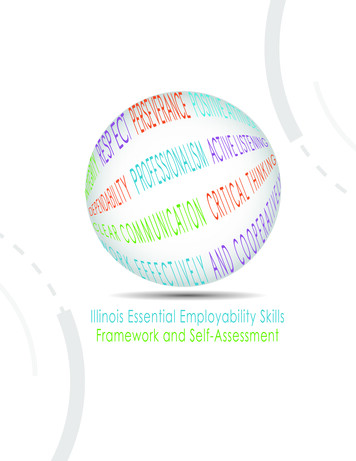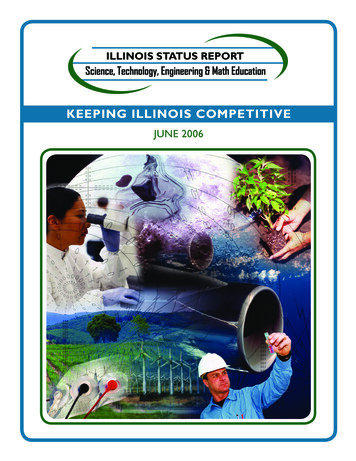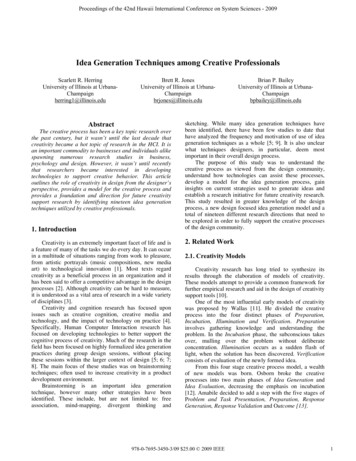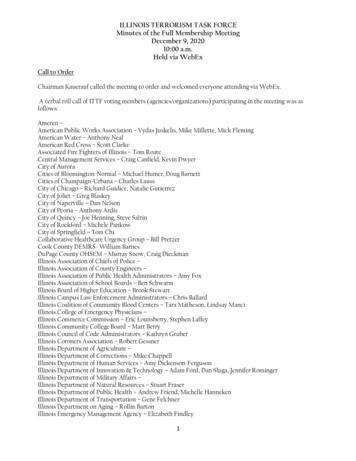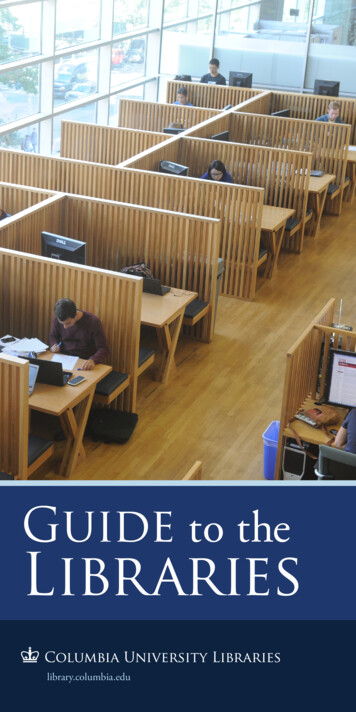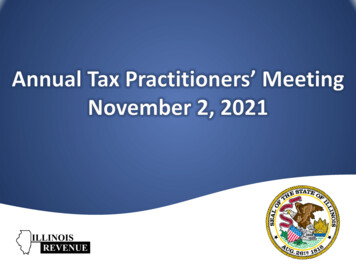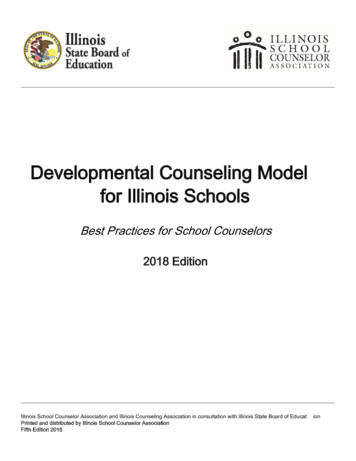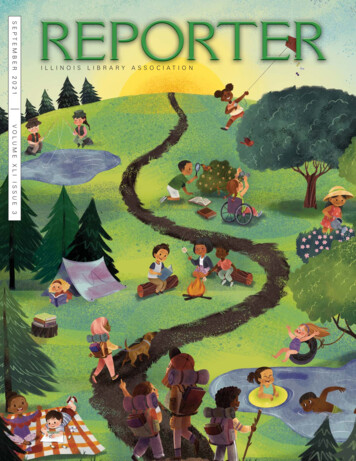
Transcription
SEPTEMBER 2021I L L I N O I SL I B R A RYA S S O C I AT I O N VOLUME XLI ISSUE 3
The Illinois Library Association Reporteris a forum for those who are improving and reinventing Illinois libraries, with articles that seek to: explorenew ideas and practices from all types of libraries and library systems; examine the challenges facing theprofession; and inform the library community and its supporters with news and comment about importantissues. The ILA Reporter is produced and circulated with the purpose of enhancing and supporting the valueof libraries, which provide free and equal access to information. This access is essential for an open democraticsociety, an informed electorate, and the advancement of knowledge for all people.ON THE COVERiREAD 2022: Read Beyond the Beaten PathFollow along over hill and dale via Jessica Gibson’s evocative artworkcreated for the iREAD Summer Reading Program’s 2022 theme witha “camp” feel. “Read Beyond the Beaten Path” combines camp, adventure,and skill development. Summer camp at the library can encompass manydifferent summer experiences, including hiking, campfires, stories, ands’mores; animal identification; arts and crafts; music and talent shows;or earning badges. Gibson is one of four featured artists; she is joined bygraphic artist Christina “Steenz” Stewart; Dav Pilkey, creator of CaptainUnderpants, Dog Man, and Dragon; and graphic artist Kayla Miller.Learn more about iREAD at ireadprogram.org.Gibson is a freelance illustrator from Detroit, Michigan. Her love of animals,nature, and picture books led her to a career in illustration, followinggraduation from Wayne County Community College. Her whimsical,expressive characters populate editorial spot pieces, packaging design,and picture books including Time to Roar (Bloomsbury, 2020), Very Lulu(Sourcebooks, 2019), and Walter Does His Best: A Frenchie Adventure inKindness and Muddy Paws (Thomas Nelson, 2021). Learn more aboutJessica Gibson at jessicamgibson.com.The Illinois Library Association is collaboratively shaping a new future for libraries inIllinois, providing leadership, advocacy, partnership, and learning for the benefit of Illinoislibraries. It is the eighth oldest library association in the world and the third largest stateassociation in the United States, with members in academic, public, school, government,and special libraries. Its 3,000 members are primarily librarians and library staff, but alsotrustees, publishers, and other supporters.The Illinois Library Association has five full-time staff members. It is governed bya sixteen-member executive board, made up of elected officers. The associationemploys the services of Blaida and Associates for legislative advocacy. ILA is a501(c)(3) charitable and educational organization.The ILA Reporter is published four times/year (Mar., June, Sep., Dec.) and is a benefitof ILA membership; the subscription rate for nonmembers is 25. ISSN 0018-9979.Designed by Verso Design Corp., Wheaton, IL. Printed by Aspen Printing Services.Indexed by EBSCO in Library & Information Science. The ILA Reporter was firstpublished in 1962.See ILA calendar for submission deadlines for the ILA Reporter. Copy should besubmitted by email to ila@ila.org. You are encouraged to include press-readydigital photos (300 p.p.i.) and graphics with your articles, which will be includedon a space-available basis.
S E P T E M B E R2 0 2 1 VO LU M EX L II S S U E3CONTENTS33 W. Grand Ave., Ste. 401 Chicago, IL 60654-6799phone: 224-698-1728 fax: 312-644-1899email: ila@ila.org www.ila.org2020/2021 EXECUTIVE BOARDPRESIDENTJeanne Hamilton, Bloomington Public LibraryV I C E P R E S I D E N T / P R E S I D E N T- E L E C THeather Jagman, DePaul University LibraryI M M E D I AT E PA S T P R E S I D E N TVeronica De Fazio, Plainfield Public Library DistrictTREASURERJoseph Filapek, Aurora Public Library Board of TrusteesD I R E C TO R S4 MOBILE PARTNERSHIP:REACHING COMMUNITIESby Pamela Thomas10 2021 CONSOLIDATED ELECTION LIBRARYREFERENDA RESULTSby Diane FooteOPINION & COMMENTARYLaura Barnes, Illinois Sustainable Technology Center,ChampaignAmber Creger, Schaumburg Township District LibraryMarielle McNeal, Edward Hines, Jr., VA Hospital,U.S. Department of Veterans Affairs, HinesRick Meyer, Decatur Public LibraryJulie M. Milavec, Downers Grove Public LibraryMegan Millen, Joliet Public LibraryKarolyn Nance, Bartlett Public Library DistrictJordan Neal, Champaign Public LibraryMichelle Oh, Northeastern Illinois UniversityKara Thorstenson, Chicago Public SchoolsA L A CO U N C I LO R12 MY TURN: SCHOOL LIBRARIANSHIP DURINGA PANDEMICby Leah GregoryPaul Mills, Fountaindale Public Library District, BolingbrookEX OFFICIODiane Foote, Illinois Library Association, ChicagoGreg McCormick, Illinois State Library, SpringfieldI L A R E P O RT E R A DV I S O RY CO M M I T T E EANNOUNCEMENTS16 READING COLORED OUR WORLD IN 2021:iREAD ROUNDUP21 2021 ILA ANNUAL CONFERENCE PREVIEW29 ILA NEW MEMBERSPamela J. Thomas, Cataloging Maintenance Center,Champaign, chairRochelle Hartman, Lincoln Library, SpringfieldAnnie Miskewitch, Schaumburg Township District LibrarySarah Rice, Forefront, ChicagoJennifer Robertson, Carbondale Public LibraryJoshua Short, Louis Latzer Memorial Library, HighlandJulie M. Milavec, Downers Grove Public Library,Executive Board liaisonSeptember 2021 ILA REPORTER3
Danielle Beasley, Susan Palmer, Sarah Taylor, and Anna Yackle, Illinois Heartland Library SystemMobile Partnerships:Reaching CommunitiesAcasual conversation can spark a series of impactfulevents. Such a moment happened during the 2021fiscal year. Susan Palmer, operations director atIllinois Heartland Library System, and LeanderSpearman, director of Belleville Public Library, were envisioningwhat library service could and should look like. Spearman wasdiscussing his vision of beginning a “co-op” of neighboringlibraries to share mobile outreach and bookmobile services.Each community would provide a vehicle that would rotateamong their communities on scheduled stops and the vehicleswould provide wi-fi access, as well as resources and items specificto a theme. He mentioned to Palmer that vans and vehiclesare needed within communities for outreach. This casualconversation got the wheels in Palmer’s head turning.Libraries have continuously worked to grow and expandtheir ever-evolving services to engage and further meet theircommunities’ needs. Many libraries in central and southernIllinois have or are just beginning to find ways to extendtheir services to reach those in need; whether it is the variousrural communities or the more highly populated areas wherethe presence of the library is not as easily known or seen.One solution is for libraries to implement the use of vehicles,such as a van or a bookmobile, to provide different servicessuch as mobile hot spots, access to technology, homebounddeliveries, signing up people for library cards, promotion of thelibrary at special events (including farmers’ markets, festivals,and parades), or sharing a permanent or rotating collectionof library materials.for more than 50 years, allowing any Illinois resident witha library card to freely request and obtain materials from anyother library in Illinois. Pooling together resources is standardpractice in IHLS to offer more to all patrons. And sometimes,brainstorming ways to share resources leads to an unexpectedand impactful series of events.Every year, IHLS offers surplus vehicles to member librariesthrough an auction at 75% trade-in value. This gives libraries theopportunity to purchase affordable vehicles for their communities.Using Spearman’s input as the starting point, as well as her visionfor this grant to be a way to give back to IHLS member librariesduring the COVID-19 pandemic, Palmer constructed the IHLSSurplus Vehicles Grant. By December 2020, a grant proposal hadbeen written. Out of the 15 libraries that applied, five librarieswere awarded a 2017 Ford Transit Cargo van. Each of the winnershas developed a concept for how the van will impact theircommunities while coming up with creative fundingand partnerships.Illinois Heartland Library System (IHLS), which services28,141 square miles in southern Illinois, is charged withthe task of providing the best possible services and resourcesto libraries to make sure that each library in the southernhalf of the state has access to as many of the available resourcesand services as possible. IHLS does this by partnering ina statewide interlibrary delivery service. Resource sharinghas been the foundation of statewide library service in IllinoisHighlighted mobile outreach loctations4ILA REPORTER September 2021
Holly Kleiss and Johnson Flanagan, library stafffrom Danville Public Library, picking up van“One solution is for librariesto implement the use of vehicles,such as a van or a bookmobile,to provide different services.”Anita Driver, director of Jerseyville Public Library, pictured with van in paradeLinda Petty, IHLS area manager, and Millicent Cason,East St. Louis Public Library director
Chris Maness, Cataloger, and Anita Driver,director of Jerseyville Public Library, picking up vanErin Steinsultz, director of Crab Orchard Library,and Stephanie Mall, program director picking up vanMetro East Mobile LibraryServices CooperativeJanet McAllister, director at Rochester Public Library, andDenise Rainford, youth services director, picking up vanFor the East St. Louis Public Library, having a van gives thecommunity and library patrons the ability to connect to theinternet to conduct business or schoolwork, or have entertainmentwithout having to add it to their monthly budget. MillicentCason, director of East St. Louis Public Library, worked to partnerwith the city, city council, and local schools to assist in raisingmoney, which has allowed them to wrap their van making it moreeye-catching and recognizable as a vehicle used by the library. TheRotary Club in this community has helped with funding as well.East St. Louis Public Library has plans for the van to go to schoolsto pass out free books, sign up kids for library cards, and providea mobile wi-fi hotspot. Another goal is the ability to visit housingcomplexes and senior communities allowing the library to reachmembers of the community with limited ability to travel tothe library otherwise by providing homebound deliveries.Other libraries were on a tight budget, such as Danville PublicLibrary, and the plans to purchase a van three to five years downthe road turned into a three-to-five-month possibility. They wereable to help their local school district in hosting a dress giveawayevent to people in their community, and it was all made possibleby having a big enough vehicle to do so. When the 2021-22school year begins, they hope to meet with the local high schoollibrarian to establish a mobile mini library in the high school andtalk about the library’s upcoming programs and events for teens.The van has also been used at a variety of local events over summer2021 and has allowed the librarians to attend more communityevents and still keep up on their normal senior residence deliveries.6ILA REPORTER September 2021At the Crab Orchard Public Library, the library director,Erin Steinsultz, has spent five years working tirelessly to improveservices for her district. She started a discussion on how to bestserve their district’s needs, and the bookmobile grant hasallowed them to provide additional services. To cut costs andstay within budget, the library opted for magnets to attach tothe side of the van instead of the more expensive wrap to beplaced on the vehicle. When faced with an unexpected challengeregarding who would drive the van and provide outreach,Steinsultz looked to her board and advocated for approval ofa new hire to fill this need. Her hard work and dedication paidoff with the board’s approval. Design ideas have been presentedto the board, and tubs are being added to the van. The libraryhas plans to start homebound deliveries, is also sponsoringa movie night, and the van will be available and stockedwith books.Janet McAllister at Rochester Public Library looked to hercommunity members for support with the implementationof the van program and was able to obtain sponsorship fromthese community members. The library surpassed its goalamount, and the project has been fantastic for their libraryoverall. Materials have been gathered to be delivered to anassisted living community through a homebound deliveryprogram. A wi-fi hotspot is another goal, as well as takingthe van to festivals, local farmers’ markets, and daycare centers.
In Jerseyville, Anita Driver had huge success promoting theirlibrary at the local parade as a showcase for their van. They havebought pop-up shelving and are starting a homebound deliveryprogram as well. The Friends of the Jerseyville Public Libraryhave even taken to using the van. The program name that theyhave come up with is JPL. If you see this van out-and-about,please give them a wave, as they have come up with magnetsfor their vans to promote JPL, so they are easily visible. Driverstated that this van has served as a great marketing tool forthe library.and time management. Hope that these hurdles can beovercome so libraries can continue to do what they do best:giving back to their communities and being a beacon oflight for those in need of their remarkable resources,while simultaneously highlighting the unmeasurable valuelibraries hold within the communities they serve. Sometimes,all it takes is a moment in a conversation to spark innovationand opportunity.Belleville Public Library was not oneof the winners of the grant, but LeanderSpearman was able to purchase two vansfor the library during a recent IHLSsurplus vehicle auction and his vision,which inspired the grant, for a sharedvehicle co-op has led to the developmentof the Metro East Mobile Library ServicesCooperative. The program was started bythree neighboring libraries that enteredinto an intergovernmental agreement toprovide mobile library services within theirshared communities. Room for expansionhas been left in the program for interestedlibraries to eventually opt in. The ultimategoal of the Metro East Mobile LibraryServices Cooperative is to have a fleet ofvehicles that can provide mobile libraryservices anywhere within St. Clair andMadison County and beyond.When looking for new and innovativeideas, libraries can come up with invaluableways to serve their communities. As needsform within these communities, libraries’dedication and creative thinking help makeit possible to fulfill whatever goal needsto be achieved, whether it is homebounddeliveries, sponsoring events, wi-fihotspots, signing up kids for library cards,or just an old-fashioned bookmobile.All these stories give us hope. Hopethat a little creativity, collaboration,and community partnership andengagement makes anything possibleto find a way to work through thehurdles libraries face every day. Hurdleslike understaffing, budget restrictions,September 2021 ILA REPORTER7
Diane Foote, Illinois Library Association 2021 ConsolidatedElection LibraryReferenda ResultsThis year there were five library-related referendain Illinois on ballots in the 2021 ConsolidatedElection, with four passing and one failing. Two thatpassed are the first ones related to library territoryannexation to occur under Public Act 101-0099: CahokiaPublic Library District and Prospect Heights Public LibraryDistrict. This law, passed in 2019, requires a “front-door”referendum when seeking to annex territory to a library district.A provision to enable disconnection of territory was eliminatedby amendment, however. To date the success of both front-doorreferenda bodes well for at least these two communities’ supportof their public library districts.CARTHAGE PUBLIC LIBRARY DISTRICTCAHOKIA PUBLIC LIBRARY DISTRICTPROSPECT HEIGHTS PUBLIC LIBRARYDISTRICTShall the bonds of the Carthage Public Library district,Hancock County, Illinois, in the amount of 1,200,000 beissued for the purpose of building and equipping a new libraryFacility, construction site improvements and furnishingnecessary equipment in connection therewith?RESULT: PassVOTER TURNOUT: 21%YES: 358 (52%)NO: 333 (48%)Shall the unserved territory of Cahokia Heights, St. ClairCounty be annexed to the Cahokia Public Library district,in St. Clair County?Shall the following described territory be annexed to theProspect Heights Public Library District, Cook County, Illinois?RESULT: PassVOTER TURNOUT: 14%YES: 1,655 (82%)NO: 267 (13%)RESULT: PassVOTER TURNOUT: 7.6%YES: 787 (79.9%)NO: 198 (20.1%)10ILA REPORTER September 2021
SHERRARD PUBLIC LIBRARY DISTRICTShall the annual public library tax rate for the Sherrard PublicLibrary District, Mercer and Rock Island Counties, Illinois, beestablised at 0.19% of full, fair cash value instead of at 0.15%,the maximum rate otherwise applicable to the next taxes tobe extended?We thank the Illinois State Library for assistance in compilingthis information, available on the Illinois State Board of Elections(ISBE) web site (Cahokia, Carthage, Sherrard, Monee) stems/ReferendaSearch.aspx and the Cook County Board of Elections web site(Prospect Heights) at .RESULT: FailVOTER TURNOUT: 21.8%YES: 185 (40%)NO: 278 (60%)VILLAGE OF MONEEShould the Village elected officials continue its efforts to havea library facility located within its corporate boundaries?RESULT: PassVOTER TURNOUT: 16.7%YES: 487 (54.3%)NO: 410 (45.7%)September 2021 ILA REPORTER11
Leah Gregory, Mascoutah Middle School My Turn:School LibrarianshipDuring a PandemicIam a middle school librarian at Mascoutah MiddleSchool in Mascoutah, Illinois. Like many otherprofessions, the day-to-day life of a school librarianwas upended completely during the COVID-19pandemic. Not everyone realizes that school librarians have two,and sometimes three, completely different sets of patrons. Firstand foremost are the kids, the students, the reason we get out ofbed every day! Second, are the teachers. I consider keeping theteachers happy one of the most significant parts of my job.And finally: the administrators, both in the building and in thedistrict. When the pandemic hit and schools were closed, allthree sets of patrons had immediate, differing, urgent needsthat I had to juggle. I was blindsided, just like everyone else,immediately wondering how I would keep the library goingand help everyone through the upheaval.Librarianship is a service profession, and while I may not becentral to the pandemic like healthcare workers, I certainly triedto keep our school and library program operating.At first, our district was entirely remote. The students left withtheir library books and whatever else they had when they wenthome the night before. In mid-March 2020, no one was sureif touching contaminated surfaces transmitted the virus, so ourdistrict prohibited checking out books. I immediately went towork ordering e-books. Our e-book collection has always beenon the small side for two reasons. First, before we went 1-to-1(meaning, each student has access to a device), there was noreliable way for students to access e-books. Second, our print12ILA REPORTER September 2021material circulation was through the roof with a robust libraryprogram in place and a healthy reading culture. Students neverseemed interested in e-books, no matter how much I tried topromote them. When faced with no other choice, many studentsbecame e-book converts overnight! This, however, presenteda problem of how to train students to use the e-books we hadavailable. In the past, I always showed interested students inperson how to access our digital books. Thus began a mixtureof joining Zoom classes to help teachers and students understandthis new access and updating the library website constantly withhow-to videos, virtual instructions, and step-by-step guides. Myinitial e-book purchases were primarily duplicates of extremelypopular print books in our collection. As time went on, I beganto better understand what kids wanted in an e-book.Also, in those first early days, teachers were scrambling with howto teach reading virtually. We didn’t know if we could recordourselves reading aloud or if copyright rules prohibited that.We didn’t have digital copies of classroom novels. I spent a lot oftime searching copyright laws and calling or emailing publishersabout permission to record read-alouds of various books. Luckily,publishers and authors came around really quickly and jumpedon board to make this process easier. Also, almost daily, I wasjuggling requests from the administration asking whetherteachers could share workbook pages or whether one thingor another was a violation of copyright law. Every day broughta new set of unknowns we were trying to navigate. I have neverspent so much time mired in copyright law.Empty Mascoutah Middle School Library during the pandemic
Full Mascoutah Middle School Library pre-pandemicOnce school was over for the 2019/2020 school year, myimmediate focus became trying to get back all the library booksthat had gone home in March. I’m still working on this. I havea steady rotation of tactics to try to get back these books,resorting to bribery, nagging, incentives, fees, begging, and so on.I have always been a proponent of forgiving lost book fees whenI can because it’s a bit of the cost of doing business as a library,and my goal is never to make it difficult for a student to checkout a book. However, the mass exodus of so many books at onetime was more than my library budget could bear to lose,so I am still working on that effect of the pandemic.When we returned to school in the fall, we were a hybrid school.We had students coming on A/B days for a shortened school day,with about 30% of our students remaining fully remote. Ouradministration initially did not see a way to circulate books. Still,with some complex research done by me and our high schoollibrarian into the REALM project conducted by IMLS in orderto assess the danger of virus transmissibility via library materials,we were able to get approval for a book delivery/pick up programwhile quarantining materials for five days after getting them back.This change caused another scramble to train students to requestbooks and understand how they would be delivered and returned.We had remote students picking up books from the office.14ILA REPORTER September 2021One of my favorite parts of my job is talking books with kidsand trying to hook them into reading particular ones. I usuallydo this in person, in an unofficial capacity, as we chat while theybrowse or check out books. I really felt the loss of not talking tothe kids, so I began e-book talks, posting a new video every daytalking about a new e-book. I also contributed to First ChapterFridays, a program our eighth-grade English Language Artsteachers started to get kids talking about new books. I createda virtual library and posted my bitmoji everywhere I could—linking the virtual library to every single team and teacher page.I also held Zoom office hours every afternoon when the teachersfinished with Zoom for the day. I made it a help-desk Zoom—students and parents could hop on my Zoom meeting, whichwas open every day from 1-3 P.M. to ask any question, not justlibrary-related ones. I helped many students reach virtual techsupport, or reset passwords for various applications they neededto get into, or directed students to their teacher’s office hours.I tried to be a friendly, helpful voice for everyone who had noidea what was going on, which was pretty much everyone!
I enjoy a great relationship with the teachers in our school,and I frequently collaborate with them in research units orinformation literacy units. With everyone trying to keepmovement around the school to a minimum, that meant takingthe research to them. At first, it was all virtual, which luckilywas relatively easy since I had converted most of our referencematerial to virtual formats several years ago. I also usedtechnology such as Google Classroom, Google Forms, Nearpod,and Loom, to make research easier for students. We adapted,revised, shifted, and changed almost every lesson or unit wetaught, so it could work remotely and in-person while stillkeeping the library portion virtual.One of my job duties has always been helping to set up onlinescheduling for parent-teacher conferences in October. Usually,this is a pretty straightforward, though time-consuming, task.This past year, however, I had to help figure out how to send allthose hundreds of parents to the correct Zoom meeting on theright day at the right time. I embraced many new technologytools for mass emails and virtually visited each teacher’s Zoommeeting to ensure there would be no problems. At the lastminute, we discovered a glitch where some teachers’ Zoommeetings had not been made public, so I ran crazily aroundthe building visiting each teacher’s classroom to make sure theyknew how to do it. I also gave out my cell phone number forthe evening so teachers could reach me if there were significantproblems. Luckily, the conferences passed smoothly, and otherthan a few new gray hairs, I was none the worse for the wear.As fall became winter, the COVID rate in our county spiked,and we began having pretty regular exposures, necessitatingquarantines. While I never was exposed and never had toquarantine, this affected me because I, along with the physicaleducation teachers, counselors, and social workers, was put intoa rotation as a substitute teacher for the quarantined faculty.Many days, they could work from home but still needed a bodyin the classroom to supervise in-person students. This rotationof subs was constantly pulled into unfamiliar schedules andclassrooms, trying to keep the doors to the school open.In January, we went to all-remote classes for one week on eachside of our Christmas break to allow students and teachers toquarantine if they had visited family during the holidays. Remoteclasses were a welcome respite to the hectic pace. The break washelpful because we opened on January 22 to a regular schedule,with all in-person students coming to school every day while stillon a shortened schedule. Teachers juggled their classrooms toallow more students in with three feet of physical distancing andmade it work. This was the beginning of getting some normalcyback to school, but the library remained delivery-only throughthe end of the school year. As of this writing, our district is backthis fall to a regular schedule and plans a traditional school year.I really, really hope that we can achieve that!“I tried tobe a friendly,helpful voicefor everyonewho hadno ideawhat wasgoing on,which waspretty mucheveryone!”September 2021 ILA REPORTER15
Reading Colored Our Worldin 2021: iREAD RoundupMore than 1,000 libraries in 36 states, plus Department ofDefense base libraries worldwide, participated in iREAD in2021, themed “Reading Colors Your World.” This summer,the broad motif of “colors” provided a context for exploringhumanity, nature, culture, and science, as well as developingprogramming that demonstrates how libraries and reading canexpand your world through kindness, growth, and community.Library patrons young and old were encouraged to be creative,try new things, explore art, and find beauty in diversity.Begun in 1981 as an Illinois-only partnership among youthservices librarians in the state, iREAD has grown to includeformal or partial statewide adoptions well beyond our borders,including in Alaska, California, Iowa, Minnesota, Oregon, andWashington (partial). In 2021, libraries decorated their spaces;conducted art projects including ink-and-fingerprint painting,a rainbow handprint wall, and colorful paper crafts; hostedgames such as “I Spy;” encouraged participants with creativeincentives such as a paper chain with loops readers contributedfor each book read; and much, much more. Here we are happyto showcase some of the creative displays put on by this year’siREADers. Read a book and color your world!We thank Alexandra Annen of the Homer Township PublicLibrary, 2021 iREAD chair, and her committee for their hardwork to develop and implement this year’s fun theme. 2021 Hervé Tullet for iREAD Summer Reading Program16ILA REPORTER September 2021 2021 Yuyi Morales for iREAD Summer Reading ProgramPekin Public Library, Illinois
Euclid Public Library, OhioRidgefield Library, ConnecticutPoplar Creek Public Library District, IllinoisKenton County Library, KentuckyRock Island Public Library, IllinoisLancaster Community Library, VirginiaPlainfield Public Library, IllinoisGlendale Library, CaliforniaPlainfield Public Library, Illinois
Poster for Early ReadersPoster for Elementary ReadersJessica Gibson is afreelance illustrator bornfrom the riverfront area ofDetroit, Michigan. A loveof animals, nature, andpicture books has alwaysinspired her to drawwhimsical, expressivecharacters and led to acareer in illustration.When Dav Pilkey was a kid, hewas diagnosed with ADHD anddyslexia. He was so disruptivein class that his teachers madehim sit out in the hallway everyday. Luckily, Dav loved to drawand make up stories, so hespent his time in the hallwaycreating his own original comicERRNVŋWKH YHU\ ƓUVW DGYHQWXUHV of Dog Man and CaptainUnderpants.Since then, Dav has writttteten and illustrated a numberof bestselling and award-winning children’s books,book Theincluding the Caldecottt HonorHh Paperboy.His Captain Underpants series and Dog Man graphicnovels have sold millions of copies worldwide andhave been translated into many languages.Jessica has producedillustrations for a numberof publishers and brands,including picture books,editorial spot pieces,packaging design, andShe says,surface patterns.t“Whatever project I workRQ , PDNH VXUH WKH ƓQDO outcomes have a realsense of fun!”2
The Illinois Library Association Reporter . music and talent shows; or earning badges. Gibson is one of four featured artists; she is joined by graphic artist Christina "Steenz" Stewart; Dav Pilkey, creator of Captain . Northeastern Illinois University Kara Thorstenson, Chicago Public Schools ALA COUNCILOR

